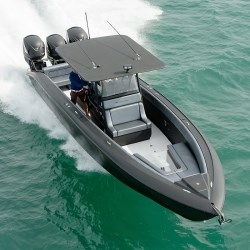Co-infused stringers and carbon fiber at Ft. Lauderdale Boat Show
Midnight Express Boats takes almost 4,000 lb out of its newest model, the 39S, with a switch to infusion and better optimized laminates.

Midnight Express Boats (Hollywood, Fla., USA) started in the 1980s and became known for indestructible, high-speed powerboats. “We have large contracts with Homeland Security and for overseas patrol boats, for example, the Trinidad & Tobago Coast Guard,” says production manager, Tague Estes. He adds that the boats are also overbuilt and solid, with some customers using four engines. “Now we can keep that strength and smooth ride, but pull the weight out,” Estes says. “We’ve cut close to 4,000 lb from our newest model, the 39S, by using infusion and better optimized laminates — hull and deck are still fiberglass — but the strength is six times greater than what we were getting with hand layup.” Owners may still use four engines, but it’s to reach new levels of speed. “Today’s customers are all about performance,” Estes explains. “If you don’t have a center console running 80 mph, you aren’t in the game.”
The Midnight Express 39S will be on display at the Ft. Lauderdale Intl. Boat Show this week (Oct. 31-Nov. 4) and features a hull and longitudinal stringers (plus aft bulkhead) that were resin infused simultaneously to save weight and time. Estes details, “We eliminated additional surface prep. and adhesive bonding, plus it addressed one of our biggest time challenges with hand layup, which is getting everything layed into the stringer grid. With co-infusion, we use jigs during the infusion process and make sure everything is perfect.” Overall build time was reduced by almost two days. Estes adds, “The more you can put into one shot, the better. You’re using the same resin, molded at the same time, and under the same conditions. It simply eliminates potential for inconsistencies.”
“This is a big boat,” says Estes, “39-ft long with a 9.6-ft beam and all the toys, yet it is probably the fastest center console in the world.” He adds that the only way to achieve that kind of performance is to drop weight. Selective use of infused carbon fiber was also key, cutting the console door weight from 150 lb to 35 lb and lightening the hard top from 335 lb to under 100 lb.
Midnight Express boats already had a reputation for standing out, with many featuring black hulls and decks. “We’ve never had any problem,” says Estes. The skin is 100 percent vinylester. Half of the boats are painted and half use gel coat. The 39S for the Ft. Lauderdale Show was painted to match the owner’s Lamborghini, using a special PPG automotive system with two types of pearl additives and silver matte finish. It also features a stepped bottom for high performance planing and speed. “It’s all about what the owner wants,” Estes remarks. “I try not to say no.” But he admits, that becomes difficult when customers want to add more gensets and special equipment without losing performance. Co-infused structures and carbon fiber help him to say yes, and still hit speed and durability targets.
Midnight Express uses vinylester resin from Interplastic Corp. (St. Paul, Minn.), non-crimp fabrics from Vectorply (Phenix City, Ala.) and woven reinforcements from BGF Industries (Greensboro, NC). It also worked with Composites Consulting Group (CCG, DeSoto, Tex.) to develop its hull-stringer co-infusion process, which is discussed in the upcoming IBEX show review in the December issue of CT magazine.
Related Content
A new era for ceramic matrix composites
CMC is expanding, with new fiber production in Europe, faster processes and higher temperature materials enabling applications for industry, hypersonics and New Space.
Read MoreCombining multifunctional thermoplastic composites, additive manufacturing for next-gen airframe structures
The DOMMINIO project combines AFP with 3D printed gyroid cores, embedded SHM sensors and smart materials for induction-driven disassembly of parts at end of life.
Read MoreTU Munich develops cuboidal conformable tanks using carbon fiber composites for increased hydrogen storage
Flat tank enabling standard platform for BEV and FCEV uses thermoplastic and thermoset composites, overwrapped skeleton design in pursuit of 25% more H2 storage.
Read MorePultrusion: The basics
A primer describing what pultrusion is, its advantages and disadvantages, and typical applications.
Read MoreRead Next
Plant tour: Daher Shap’in TechCenter and composites production plant, Saint-Aignan-de-Grandlieu, France
Co-located R&D and production advance OOA thermosets, thermoplastics, welding, recycling and digital technologies for faster processing and certification of lighter, more sustainable composites.
Read More“Structured air” TPS safeguards composite structures
Powered by an 85% air/15% pure polyimide aerogel, Blueshift’s novel material system protects structures during transient thermal events from -200°C to beyond 2400°C for rockets, battery boxes and more.
Read MoreDeveloping bonded composite repair for ships, offshore units
Bureau Veritas and industry partners issue guidelines and pave the way for certification via StrengthBond Offshore project.
Read More






















